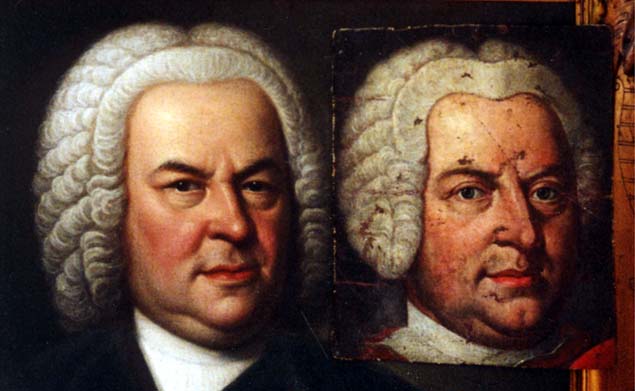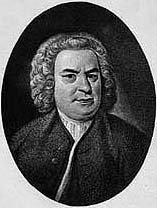The Critical Discographies from Choral Music On Records - Saint Matthew Passion Pages at the Teri Noel Towe
Home Pages
Johann Sebastian Bach
The Critical Discographies from Choral Music On Records
This remarkable photograph is not a computer generated composite; the original of the Weydenhammer
Portrait Fragment, all that remains of the portrait of Johann Sebastian Bach that belonged to his pupil
Johann Christian Kittel, is resting gently on the surface of the original of the 1748 Elias Gottlob Haussmann
Portrait of Johann Sebastian Bach.

1748 Elias Gottlob Haussmann Portrait, Courtesy of William H. Scheide, Princeton, New Jersey
Weydenhammer Portrait Fragment, ca. 1733, Artist Unknown, Courtesy of the Weydenhammer Descendants
Photograph by Teri Noel Towe
©Teri Noel Towe, 2001, All Rights Reserved
The Critical Discographies from Choral Music On Records
Saint Matthew Passion, BWV 244
Saint Matthew Passion, BWV 244
The Charismatic Iconoclasts
Still, Otto Klemperer and Sir Georg Solti are the exceptions not the rule. Charismatic conductors of
international stature are rarely musical conservatives either consciously or unconsciously intent on
preserving established performance traditions, no matter how important they may be. Powerful creative or
recreative personalities are usually egocentrics who seek to go their own ways and to create styles of their
own. The performance traditions associated with the Saint Matthew Passion are not immune from this
reality. After all, Mendelssohn-Bartholdy had no knowledge of Bach's performance practice and no real
interest in it. For him the Saint Matthew Passion was contemporary music to be played in a contemporary
fashion. Most of the great charismatic conductors of the 20th century have viewed the score in the same
way, and in so doing, without wanton intent, have done much not only to dilute the
Mendelssohn-Bartholdy tradition but also to foster in the minds of most listeners a fundamental
misconception about 19th century Bach performance practice, which was a lot more straight forward and
urgent than most would believe on the basis of the few "old" recordings they know, none of which is
representative of true 19th century style.
As luck would have it, the first complete recording of the Saint Matthew Passion was made by just such
a charismatic conductor, one who had, furthermore, no knowledge of the Mendelssohnian traditions. [21]
That man was Serge Koussevitzky, the Russian born double bass virtuoso who conducted the Boston
Symphony Orchestra for 25 years. His SMP is a free wheeling affair to say the least, eccentric and
Romantic in an almost Tschaikowskyian sense. He may have had no more knowledge of "correct" Bach
performance practice than the Gilbertian novice in a nunnery, but he had the sense -- and the courage -- to
perform the work in its entirety. He engaged the services of the distinguished German emigré
harpsichordist Ernst Victor Wolff to accompany the Evangelist and fill in the figured bass in many of the
solos; he also hired the pioneer gambist Alfred Zighera to play the obligatto in "Komm, süsses Kreuz" and
the preceding arioso. But Koussevitzky couldn't stomach the notion of "Geduld, Geduld" with a simple
continuo accompaniment; The harmonies are realized in a fully written out, through composed setting for
full string orchestra.
While all are more than adequate, none of the soloists other than Keith Falkner, however, is memorable,
and Koussevitzky's recording is now valuable primarily as an extremely rare collector's item. But one
singer who received no credit for his participation in this gargantuan undertaking went on to fame and
fortune. He was a Harvard undergraduate and a member of the Glee Club at the time. He became a protegé
of Koussevitzky's and a charismatic "big name" conductor in his own right. His name is Leonard
Bernstein, and he, too, recorded the SMP in English. [30]
Bernstein's, however, is a severely abridged, extroverted, sharp edged, operatic account that ultimately is
scuttled by inadequate soloists - a querulous, bleaty Evangelist, a stentorian Jesus, a solid clear voiced
soprano who approaches every note above the staff with fear and trepidation. Only the molten voiced
mezzo-soprano Betty Allen is truly enjoyable to hear, and one wishes that Charles Bressler, though not in
his best form, has sung the Evangelist's narrative in addition to the two tenor solos that did not end up on
the cutting room floor.
A performance of Part One by the New York Philharmonic under the direction Bruno Walter, Bernstein's
other great mentor, that was broadcast on April 18, 1943, has survived in dull and rather muddy sound,
and it circulated semi-privately in the early 1970s. [31] (Part Two, which aired the following week, also is
rumored to exist, but it has not as yet surfaced.) Sung in the Henry S. Drinker translation, the performance
is rather Mahlerian in tone, but it is not as extreme as Koussevitzky's or Mengelberg's. Walter makes no
cuts, per se, but he does find it convenient to playing only the reprise of the opening ritornellos of the four
da capo arias in Part One.
Perhaps the greatest culprit, if you will, among the "big name" conductors is Willem Mengelberg, the
brilliant and eccentric conductor of the Concertgebouw Orchestra of Amsterdam whose abridged Palm
Sunday, 1939, concert performance of the SMP was one of the first to be released on long playing
records. [32] An effusive, and "Romantic" performance to say the least, Mengelberg's intensely personal
view of the SMP is replete with grand ritards, neo-Mahlerian plasticity, rubati within rubati and phrases
within phrases, and a fastidious attention to details of dynamics within phrases. The eccentricities, great
and small, are legion. A description of a tiny one will suffice: Nearly every chord in the recitatives is
broken, strummed on the harpsichord as though it were a lute or a guitar. Needless to say a large chorus
and orchestra are used.
The soloists are uneven. Louis van Tulder sounds pinched and pressed in the tenor arias, and Willem
Ravelli, the Jesus, has a rather tight wobble, but his is a characterization of great reserve, resignation, and
sensitivity. Karl Erb was in better voice in the Ramin "studio" recording made two years later, but he was
indisputably one of the premier Evangelists of all time, and more of the rôle can be heard here. Jo Vincent
had a special soprano voice, radiant and burnished, pure and very tightly focussed.
Piet van Egmond, who played organ continuo in the Mengelberg performance, recorded an uncut SMP in
the early 1950s. [33] Although he is nowhere near as effusive or idiosyncratic, Egmond was obviously
heavily influenced by Mengelberg. Once again, a large chorus and orchestra are called into play. The
singing, from chorus and soloists alike, is quite raw.
The large shadow that Mengelberg's approach to the SMP cast in the Netherlands can be felt in Anthon
van der Horst's recording, which was made in concert in the Grote Kerk in Naarden in 1957. [34] The
tactus is slow in this performance, in which the gamba versions of "Mein Jesus schweigt" and "Geduld,
Geduld" are employed. Dr. van der Horst was inclined to the scholarly, and he pays more than casual
attention to the principles of "correct" performance practice. Mengelberg's much tempered influence can
nonetheless still be felt in the careful highlighting of inner voices in choruses and arias alike. The soloists
are uneven. Best is Tom Brand, a pure voiced Evangelist with security and power at the top end of his
register.
In its way, Wilhelm Furtwängler's concert performance of April 14, 1954, is as eccentric and iconoclastic
as Mengelberg's. [35] That this recreative genius is beholden to no tradition, no matter how venerable and
no matter how worthy, becomes apparent in the opening chorus. He inserts momentum breaking caesuras
between the Chorus One "Sehet"s and the Chorus Two responses. A single-minded determination to
create an intensely dramatic, operatic interpretation sweeps all before it. As Jesus, the clear voiced, straight
forward Fischer-Dieskau knuckles under to Furtwängler's interpretative demands, and so do all the other
soloists, the chorus, and the orchestra in this weird but often powerful reading. The score is disfigured by
cuts that are almost as extreme as those made by Ramin, Kittel, and Mengelberg. Except for
Fischer-Dieskau and the dramatic and tonally beautiful Elisabeth Grümmer, the soloists leave much to be
desired. Höffgen is weak and wobbly; subsequent sterling performances leave no doubt that she was
simply having an off day. Dermota tends to over-inflect and over-interpret, which works fine within the
Furtwänglerian context, but he strains at the top in the Evangelist's recitatives. The less said about Otto
Edelmann's voice, which had deteriorated badly in the four years since he had sung in Karajan's uncut
SMP at the 1950 Bach Festival in Vienna [36], the better.
There are some wonderful moments, nonetheless: A hushed a capella "Wenn ich einmal soll scheiden" of
ethereal beauty and a "Komm, süsses Kreuz" - with the gamba obligato adjusted to suit the 'cello - taken at
a tempo slow enough to make the onomatopoetic dragging of the cross especially vivid come immediately
to mind. Still, Furtwängler's is a fussy, gooey, and turgid SMP best left to his idolators.
Even in 1950, at the age of 43, Herbert von Karajan qualified as a charismatic "big name" conductor, and
his complete and uncut SMP from that year contrasts sharply with Furtwängler's. [36] Karajan's is a
powerful and dramatic reading, Michelangelesque in its monumentality; he often borders on the excessive
but never crosses over the line into the maudlin or the self indulgent. He has the benefit of an extraordinary
cast. Walther Ludwig is a passionate, committed, and electrum throated tenor soloist, an Evangelist to be
reckoned with. Irmgard Seefried is pure and impassioned in the soprano solos, and it is wonderful to have
a recording of the unique Kathleen Ferrier singing all of the alto's solos in German. The balances, however,
are poor, and the dry sound varies from clear to muddy throughout this recording, which apparently was
salvaged from a homemade "off the air" tape.
Little changed in the nearly 25 years that elapsed before Karajan made his studio recording of the SMP.
[37] The sound is rich hued but oddly artificial, as seems to have been the conductor's preference. The
reading has become quite self-indulgent and idiosyncratic, but it remains powerful nonetheless; in fact for
those who prefer a "heart on the sleeve" approach to the Saint Matthew Passion, this set is one of the
two best choices. Once again, the overall tactus is slow, the approach colorful but restrained. Schreier is
again a top notch Evangelist, Dietrich Fischer-Dieskau a forthright and unpretentious Jesus, and Christa
Ludwig powerful in the alto solos, but Walter Berry's voice is painfully tight above the staff, particularly in
the exceedingly deliberately paced "Gebt mir meinen Jesum wieder". Karajan chose the 1741 version of
"Mein Jesus schweigt", but seems to have had the part played on the 'cello; he himself makes a cameo
appearance as the organist in a maddeningly slow "Geduld, Geduld". "Wenn ich einmal soll scheiden" is
sung a capella, as it was in the 1950 Bach Festival performance.
Eugen Jochum's set is the other good choice for those who prefer an emotionally extroverted
interpretation of the Saint Matthew Passion. [38] His is a loving, supple, dramatic, and colorful reading,
with much ebb and flow, and a full range of dynamics, crescendos, and diminuendos. Another of the truly
great Evangelists, Haefliger shows little vocal strain and yet greater emotional depth in this, his next to last
recording of the rôle. As Jesus, Walter Berry proves dignified, solid, and mature, but never stuffy. The
sensitive John Van Kesteren, however, had begun to sound a tad weary by the time he recorded the tenor
arias for Jochum.
Even more gorgeous but, alas, much more difficult to obtain is the Pablo Casals broadcast performance
from June, 1963. [39] The then 86 year old Catalan 'cellist and conductor had a singular approach to
music in general and Bach in particular. His compassionate interpretation is at once supple and incisive,
emotional and restrained. The tonal and vocal colors are intense but subtle from the first moment to the
last in this remarkable account, which is surprisingly Mendelssohnian in character. One regrets only that it
is sung in English, particularly since Haefliger is the Evangelist! The other soloists are all of equally high
calibre, and hearing the rich and pure soprano of Olga Iglesias makes the listener regret that this fine
Puerto Rican vocalist chose not to pursue an international career. The instrumental playing is of an
especially high order; in the those days the Festival Casals de Puerto Rico Orchestra was the greatest
"pick-up" ensemble in the world; concertmasters from major orchestras gladly played at rear desks in the
second violin section. The Cleveland Orchestra Chorus was prepared by Robert Shaw.
Certainly one of the more eccentric of the "big name" interpretations is Ralph Vaughan Williams's [40],
recorded on March 5, 1958, less than seven months before his death, at the last of the 23 performances of
the Saint Matthew Passion that he had conducted since 1931. RVW's is a very fluid, vibrantly colored,
highly Romantic interpretation, most notable for a flamboyant realization of the basso continuo for the
piano. (Like Sir Thomas Beecham, Vaughan Williams evidently hated the harpsichord with an almost
religious fervor.) Liberally laced with sinuous and peculiar inner voices, this free wheeling, through
composed part is anachronistic with a vengeance, and not without some alterations of Bach's indicated
harmonies; at especially dramatic moments there are thick, grace-noted chords that call to mind the
concluding bars of the Bach-Busoni Chaconne.
The orchestra, a mélange of professionals and amateurs, and the amateur chorus, are adequate, the
soloists rarely more than passable in this abridged English language performance. The Evangelist, Eric
Greene, who was highly regarded in his day, but by this stage in his career his voice was in tatters; the
straining for the high notes is painful and much more pronounced than in the nearly complete English
language set recorded nearly ten years before under the direction of Reginald Jacques. [41]
Jacques's is an essentially Romantic performance that is valuable primarily as a souvenir of Kathleen
Ferrier's distinctive voice, but she did better for Karajan in Vienna two years later. Of the other soloists,
Elsie Suddaby is far and away the most satisfactory; her voice is light, fresh, and clear. Eric Greene, as
intimated earlier, is dry and timorous; so is Henry Cummings, who sings Jesus.
This kind of dry and querulous vocal production seems to have been prevalent in England if the few 78
RPM recordings that were made can be taken as indicative. Silver throated tenors like Walter Widdop
seem to have been something of an anomaly in English Bach performances in those days. Two discs of
excerpts recorded by a "Special Choir" under the direction of Dr. Ernest Bullock in Westminster Abbey
about 1930 are a case in point. [42] The unnamed soloists are hooty and shrill; their voices are constricted
and bleaty. The Evangelist sounds like Eric Greene; if it is in fact he, his voice was dry and tight even then.
The choir is vast, the interpretation soupy.
Even gooier, however, is a brutally truncated version of the SMP, "newly arranged and edited by David
McKinley Williams", who conducts from the organ. [43] Recorded in St. Bartholomew's Church in New
York, this twelve disc set was the first attempt at a "complete" Saint Matthew Passion. A theatrical, sugar
coated disaster, the interpretation is memorable only because of the participation of the tenor Allan Jones,
who later went to Hollywood and played the Romantic male lead in the famous Marx Brothers comedy A
Night at the Opera. Jones ranks among the most powerful and emotive Evangelists. His is a big and
intense voice of great power; his diction is superb. Hollywood's gain was classical music's loss.
In better taste but of similar limited interest is the single LP recorded in the early '50s by the Handel
Oratorio Society of Augustana College in Rockford, Illinois. [44] Billed as a "Musical Digest" arranged by
Lura Stover, the soprano in this English language performance, the SMP is reduced to a simple narrative
interspersed with excerpts from a handful of arias and choruses, with the instrumental ritornellos either
abridged or cut altogether. The four better than average soloists and the 400 voice choir are accompanied
on the organ.
From Canada in the early '50s came a recording of the SMP under the baton of Sir Ernest MacMillan. [45]
With a large chorus and orchestra, this somewhat abridged performance has little to recommend it.
Edward Johnson has a rather tight wobble but has little difficulty with the range of the Evangelist's music.
The bright spot is soprano Lois Marshall. Her distinctive, trumpet like voice still has the bloom of youth
on it, and her interpretations evince great sensitivity.
A more interesting recorded document from the same period is an LP side of excerpts from the first
performance of the Saint Matthew Passion given in Moscow, under the direction of the Latvian choral
conductor Janis Dumins. [46] Recorded in the Great Hall of the Moscow Conservatory during the 1956 -
1957 season, the performance is in no way eccentric; it is cast in the middle-of-the-road Eastern European
legato style, but it eschews Romantic excess except for a big decrescendo at the end of the final chorus.
The whole performance certainly would be worth hearing.
Please click here to advance to Page 4 - The Straube/Ramin Tradition
Endnotes
Alphabetical Discography
Please click here to return to the Critical Discographies from Choral Music On Records Main Page.
P. S.: Please don't forget that, if you are interested in a thorough, accurate discography of the recordings
of the Saint Matthew Passion that have appeared since the preparation of this article, you should go at
once to Aryeh Oron's remarkable Bach Cantatas Website.
Please click on  to return to the Johann Sebastian Bach Index Page.
to return to the Johann Sebastian Bach Index Page.
Please click on the  to return to the Teri Noel Towe Welcome Page.
to return to the Teri Noel Towe Welcome Page.
teritowe@alumni.Princeton.EDU
Copyright, Teri Noel Towe, 1989, 1997, 2001
All Rights Reserved
The The Critical Discographies from Choral Music On Records - Saint Matthew Passion Pages
at the Teri Noel Towe Home Pages are PPP Free web pages.

The The Critical Discographies from Choral Music On Records - Saint Matthew Passion Pages
at the Teri Noel Towe Home Pages have received the HIP Woolly Mammoth Stamp of Approval from
The HIP-ocrisy Home Page.